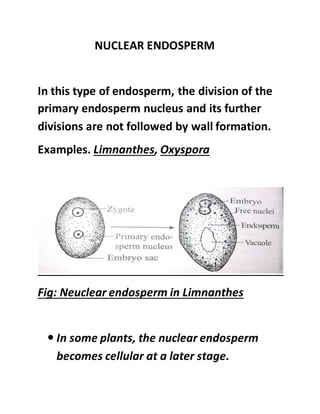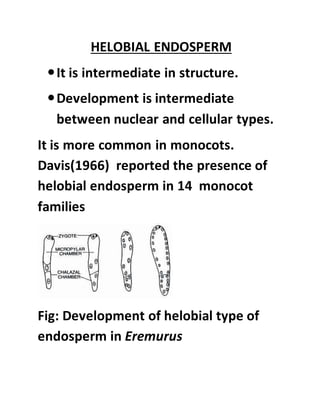Types of endosperm
- 1. PRESENTATION ON ‘TYPES OF ENDOSPERM’ GUIDED BY- PRESENTED BY- DR. NAMITA NATH RASHMI H. RAHMAN M.SC 2ND SEM DEPT OF BOTANY ROLL NO 3 GAUHATI UNIVERSITY
- 3. INTRODUCTION Endosperm is a nutritive tissue stored in the seed for the embryo and it is formed by the fusion of one male gamete with the polar nuclei. -Endosperm plays a main role in the diet of human beings. -Endosperm is found in all angiosperms except few families like Orchidaceae,Podostemonaceae and Trapaceae. -The seeds without endosperm: Non- endospermous seeds or exalbuminous seed. -The seed containing the endosperm: Endospermous or albuminous seed.
- 4. EXAMPLES OF ALBUMINOUS AND EXALBUMINOUS SEED: Castor Pea
- 5. TYPES OF ENDOSPERM -Endosperm is classified into 3 types by Schnarf(1929) on the basis of their mode of development: 1.Nuclear endosperm 2.Cellular endosperm 3.Helobial endosperm Fig: A-Nuclear ,B-Helobial C- Cellular endosperm
- 6. NUCLEAR ENDOSPERM In this type of endosperm, the division of the primary endosperm nucleus and its further divisions are not followed by wall formation. Examples. Limnanthes, Oxyspora Fig: Neuclear endosperm in Limnanthes In some plants, the nuclear endosperm becomes cellular at a later stage.
- 7. Ex. Acalypha, Phaseolus. Fig: A-E; stages in the development of Neuclear type of endosperm CELLULARIZATION OF NUCLEAR ENDOSPERM The cellularization of nuclear endosperm shows variations. In Acalypha,the endosperm becomes cellular completely. In Grevillea, the endosperm is cellular in the micropylar region and nuclear in the chalazal
- 8. end. The nuclear chalazal end develops into a vermiform appendix (Kausik,1941 Fig: Endosperm formation in Acalypha In coconut,the endosperm is nuclear type. Later on it becomes cellular.The PEN undergoes several free nuclear divisions. The endosperm in coconut is partly solid and partly liquid.
- 9. Fig: Endosperm formation in Cocos nucifera CELLULAR ENDOSPERM The division of the PEN and its further divisions are followed by immediate wall formation and the free nuclear stage is completely absent. It is common in dicots. Haustoria are common.
- 10. Fig: Development of cellular endosperm in Drimys winteri Haustoria in Cellular Endosperm The haustoria may arise at the micropylar end or at the chalazal end or both. In Impatiens , micropylar haustorium is produced. In Nemophila both micropylar and chalazal haustoria are found.
- 11. Fig: Endosperm in Nemophila Fig: Micropylar haustorium in Impatiens
- 12. HELOBIAL ENDOSPERM It is intermediate in structure. Development is intermediate between nuclear and cellular types. It is more common in monocots. Davis(1966) reported the presence of helobial endosperm in 14 monocot families Fig: Development of helobial type of endosperm in Eremurus
- 14. RUMINATE ENDOSPERM Endosperm having irregular ridges and furrows on the surface. E.g Areca catechu, Myristica Fig: Ruminate endosperm in Myristica
- 15. REFERENCE: 1. THE EMBRYOLOGY OF ANGIOSPERMS, 5TH EDITION, S S BHOJWANI & S P BHATNAGAR 2. DEVELOPMENTAL BOTANY AND EXPERIMENTAL EMBRYOLOGY, ANNIE KUMMARESAN 3. www.publishyourarticles.net















